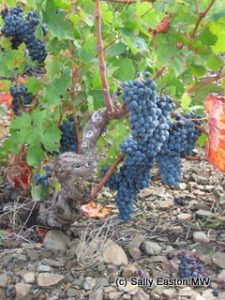Wine and chocolate
A version of this article first appeared in Food Development magazine, March 2007.
One of the latest trends has become to speak about chocolate in wine terms: variety of cocoa bean, origin of bean, how it is grown, climate, soil, terroir, and quality differentials with all of these. Sara Jayne Stanes, director of the Academy of Culinary Arts, and chairman of the Academy of Chocolate said: “There are three major varieties of bean, with nearly 300 hybrids. Cocoa beans are full of tannins, fruits, spices, herbs, grassy, woody and smoky flavours.”
For serious, fine, dark chocolate, Jo Stewart, chocolate buyer at Harrods said: “The trend is single estate chocolate, and some of the dark, bitter chocolates go well with wine. Peruvian chocolate tastes different from other parts of South America. It is bitter, but erring on the side of fruity, and it’s the fruitiness that goes with wine.”
Savoury dishes

Bernd Flemming
Chocolate in savoury dishes is less challenging than sweet dishes, as it should not make the dish sweet. Bernd Flemming, who gained his Michelin star at the Restaurant Français in Frankfurt and now runs a food development consultancy said: “The cocoa has a special flavour. We always think chocolate is something to do with sweetness but cocoa is a spice like vanilla, or chilli. We use it as a spice, for example in the Mexican mole dish. And like a spice, used in the quantities of a spice or condiment, chocolate balances the taste between the sweet ingredients and spicy ingredients. It doesn’t really change the texture.”
At a recent wine and chocolate evening, Anne Tupker MW, of Bouquet Wines, paired a 2002 St Joseph with Roe deer with Diva chocolate sauce. She said: “The slight gaminess of the syrah plus the richness and acidity of the wine went well with the venison and with the richness of the sauce.” She added “the richness chocolate gives to the sauce calls for a wine that is fruity, concentrated and with some good acid bite but fairly light, smooth-textured tannin.”
Desserts and petits fours
For sweet dishes, the sweetness has to be at the same level. Tupker said: “A 1977 Graham’s port with with a dark chocolate and praline dessert went down a treat. A five or six puttonyos Tokaji, or a trockenbeerenauslese from Germany or Austria would also work.”
Sarah-Jane Evans MW, one of the founders of the Academy of Chocolate, reiterated the superior chocolate designation for wine pairing opportunities. She said “The tastings we do are with bars, not prepared dishes, which makes a difference. I have found that the fortified wines can work. If you have something rich and sweet, you need something hefty in alcohol. Young Maury with dark chocolate gives a luscious, lovely, red fruited character, with aromatic fruitiness an extra complement.”

Ripening grenache in Roussillon
Maury, along with Banyuls and Rivesaltes are the sweet, fortified red, vins doux naturels wines of Roussillon in the south of France, made from grenache. The style is either young primary fruit focused, with rasp-, black- and blueberry flavours, which works well with creamy sweet and silky-textured truffles, such as Prestat‘s Dark Chocolate Marc de Champagne Truffles, or a more oxidative style, where complex aromas of coffee, chocolate, caramel, walnuts, dried figs and prunes pair well with nuttier desserts and bars of 70%+ cocoa.
A youthful LBV (late bottled vintage) port such at Taylor’s is a good alternative, with vibrant black cherry, bramble and raspberry fruits to accompany and lift the concentration of the dark chocolate. Flemming said “I like a chocolate terrine with port wine and figs, and I’d serve a port with it. Cook the figs in port, with a hint of chilli, melted dark chocolate, crème fraiche, eggs and butter. On a biscuit and pistachio base, add the fig and port mixture with layers of chocolate. Warm the remaining port with chocolate to thicken.”
Gearoid Devaney, head sommelier at one-Michelin star London restaurant Tom Aikens said “with [chef] Tom there are always more flavours, for example chocolate fondant with grapefruit. There are always twists in the tail to deal with. I choose wines according to the richness and texture. Tokaji, for example from Istvan Szepsy, works better than French [Sauternes]. I’m using a vins doux naturel Rasteau from Domaine Romero because it has a good bit of acidity, which plays with the sharpness of the grapefruit.” Devaney treats each dessert on its own merit, saying he loves looking at how you can play with the palate. Italy’s passito wines might feature, or an older Malmsey Madeira from Henriques and Henriques. He said: “you have that heat from the alcohol, but chill it a little, and serve a 15 year old with petit fours.”
Conclusion
The sweet, gamey, concentrated fruit and silky tannins of dry syrah/shiraz was may complement the rich texture of a chocolate-influenced savoury dish, but it seems the fortified wines come into their own for dessert. Red fruits and spiciness are found in both dark chocolate and wine. As sweetness increases, or the chocolate is combined with other complexing flavours, better matches may move away from fortified wines to styles such as passito, Tokaji, or even trockenbeerenauslese, where sweetness, acidity and flavour are concentrated in the grape by sun-drying or very late harvesting.



